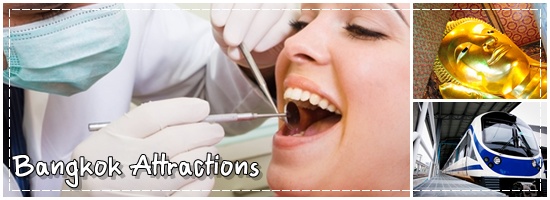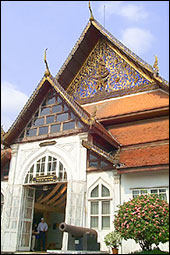
National Museum
 The first museum in Thailand was
established at the Grand Palace
to include the private
collection of antiquities of
King Mongkut (King Rama IV,
1851-1868). The first public
museum in Thailand was founded
in 1874 by his son, King
Chulalongkorn (King Rama V,
1868-1910). The collection
included his personal art
objects and antiquities, mounted
stuffed animals purchased in
Europe and the United States,
skeletons, rocks and minerals. The first museum in Thailand was
established at the Grand Palace
to include the private
collection of antiquities of
King Mongkut (King Rama IV,
1851-1868). The first public
museum in Thailand was founded
in 1874 by his son, King
Chulalongkorn (King Rama V,
1868-1910). The collection
included his personal art
objects and antiquities, mounted
stuffed animals purchased in
Europe and the United States,
skeletons, rocks and minerals.
In 1926, King Prajadhipok (King
Rama VII, 1925-1934) established
the Royal Institute of Art,
Literature and Archaeology. The
Bangkok Museum, then under the
supervision of the Royal
Institute, was reorganized into
a museum of art and archaeology
and moved to the "Palace to the
Front" or "Wang Na" which has
been the palace of the Prince
Successor. The collections
devoted to cultural heritage
were enlarged and the museum
became the Bangkok National
Museum.
There are 38 national museums
throughout the country included
in a museum network divided into
four categories: regional, site,
provincial and monastery.
The Bangkok National Museum is
dedicated to preserving the
national cultural heritage
through collections of art,
archaeological and cultural
objects in the Palace of Wang Na
compound near the Grand Palace.
The Gallery of Thai History is
located in the Sivamokhaphiman
Hall, with the Prehistory Galley
at the rear of the building. The
History of Art collection is
displayed in the South and North
Wings and the Minor arts, Royal
Cremation Chariots and
Ceremonial Objects are exhibited
nearby in other buildings within
the palace compound.
The visit starts with a useful
introduction to Thai history.
Note the black-stone inscription
form Sukhothai, the oldest-known
record of the Thai alphabet. Two
large modern buildings house the
main collection of pre-Thailand
Thai sculpture, as well as
pieces from elsewhere in Asia.
An important exhibit in the
southern wing is one of the
earliest images of the Buddha
from Gandhara in India, clearly
influenced by classical Greek
sculpture. A garage in a nearby
building houses the collection
of magnificent royal funeral
chariots. Vajayant Rajarot is
still used even though it needs
300 men to pull it.
In the past, the Front Palace
was of secondary importance only
to the main palace, and was the
residence of Somdet Chao Phraya
Maha Surasinghanat, the heir
apparent. The many buildings
inside include Bhuddhasawan
Chapel, Tamnak Daeng (Red
House), Mungkhalaphisek
Pavilion, and Sala Longsong
Pavilion, considered to be
"Outstanding examples of
traditional Thai architecture."
Free
English-language tours of the museum are given by
National Museum volunteers on
Wednesdays (Buddhism) and
Thursdays (Thai arts, religion
and culture), starting from
9:30am. These guided tours are
excellent and many people have
written to recommend them.The
tours are also conducted in
German (Thursdays), French and
Japanese (Wednesdays). For more
information: contact the
volunteers (Telephone 215-8173).
|